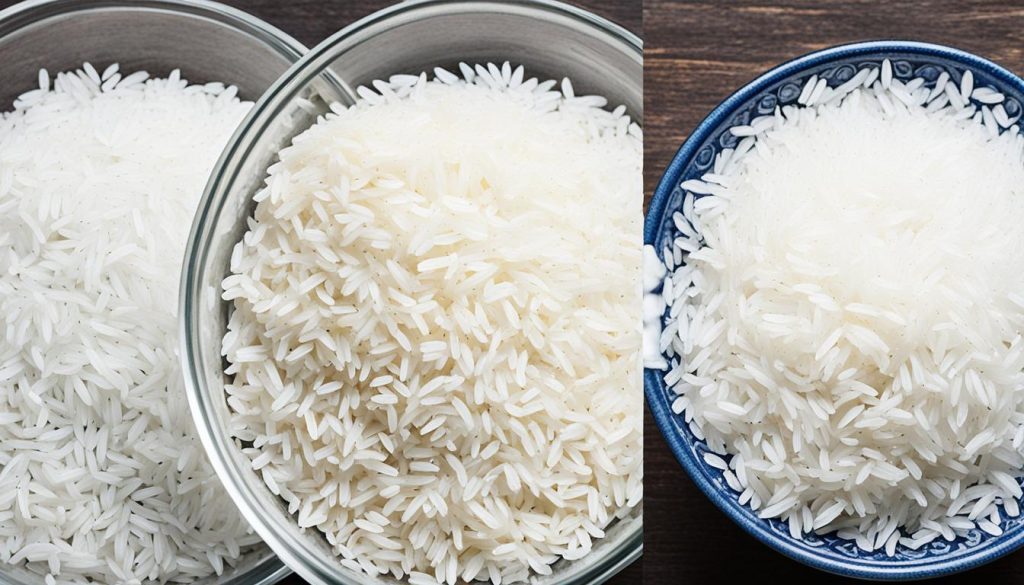Cooking perfect white rice is key in every kitchen, for quick meals or fancy dinners. The key to fluffy, tasty white rice is a few easy tricks. These can turn simple grains into a standout dish. Let’s look at the top ways to cook white rice for that sought-after perfect texture.
Rinsing the rice before cooking is critical. It removes extra starch and prevents a gummy texture. To rinse rice, put it in a fine mesh strainer and run water over it. Move the rice around gently until the water is clear. If the water’s not perfectly clear, that’s okay, as long as there’s no more starch clouding it.
To make your white rice even tastier, toast the grains with a little butter or oil first. This step adds a lovely, nutty aroma like fresh popcorn. Also, add some salt to the water as it boils. This enhances the final rice flavor, making it more delicious.
After cooking, “fluff” the rice with a fork. This removes clumps and makes it light and fluffy. This step is key to solving any clumping issues and ensures your rice is perfect.
Key Takeaways
- Rinsing the rice before cooking removes excess starch for a better texture.
- Toasting the rice in butter or oil enhances the natural nutty flavor.
- Adding a pinch of salt to the cooking water balances the overall taste.
- Fluffing the cooked rice with a fork breaks up any clumped grains.
- Following these simple steps will help you achieve perfectly cooked white rice every time.
Why Rinsing Rice is Essential
Rinsing white rice before cooking is vital. It removes extra starch. This starch makes the rice stick and turn gummy. By rinsing well, you ensure your white rice turns out fluffy and perfect every time.
Removing Excess Starch
The main goal of rinse rice is getting rid of the excess starch. This starch makes rice sticky and clump. To do this, put the rice in a strainer. Run water through it, moving the grains around with your hands. This action removes the extra starch, giving you clean, single grains of rice.
Achieving Fluffy Texture
Rinsing also makes your cooked rice light and fluffy. Thoroughly rinsed rice grains don’t stick together. This keeps each grain airy, not dense. Achieving a fluffy rice texture means perfecting the art of rinsing.
Getting the Rice to Water Ratio Right
It’s key to get the perfect rice-to-water ratio for fluffy white rice. Use 1 cup of rice to 1.5 cups of water when cooking on the stovetop. You can cook larger amounts with this ratio, just make sure your pot is big enough.
Standard Ratio: 1 Cup Rice to 1.5 Cups Water
The 1:1.5 rice cooking ratio is a solid choice for stovetop white rice. This balance makes sure every grain gets the water it needs. The result is light and fluffy rice.
Adjusting for Different Rice Varieties
Not all rice follows the 1:1.5 rule. Brown or Arborio rice might need more water for a soft texture. Always double-check on the package or ask a pro for the right rice to water ratio. This helps get the best results for any type of rice you’re cooking.

The Classic Stovetop Method
For the classic stovetop method of cooking white rice, begin by boiling water in a saucepan. Add a pinch of salt and the rice when the water boils. Then, lower the heat, cover the pot tightly, and let it simmer gently.
Simmering and Steaming the Rice
Let the white rice cook without peeking or stirring for about 18 minutes. This allows it to absorb the water and become tender.
Letting the Rice Rest
After 18 minutes, turn off the heat but leave the rice covered for 10 more minutes. This step makes the white rice fluffy and well-cooked.
Troubleshooting Common Issues
Cooking white rice might seem easy, but there can be hurdles. Let’s look into these problems and their fixes.
Undercooked or Overcooked Rice
If your rice is too crunchy, add a bit more water. About 1/4 cup per cup of rice should do. Cover and cook on low for 5 more minutes. This should make it just right.
If your rice turns mushy, try laying it out on a sheet to dry. It can fix the too-soft texture.
Sticky or Gummy Texture
Rice can get sticky if you skip rinsing. Always rinse your rice in a strainer until the water is clear. This removes extra starch and prevents it from being too sticky.
Burnt or Scorched Rice
It could be burnt if the pot’s too big or the heat is too high. Use a pot of the right size and keep the heat low. This stops the rice from burning at the bottom.


